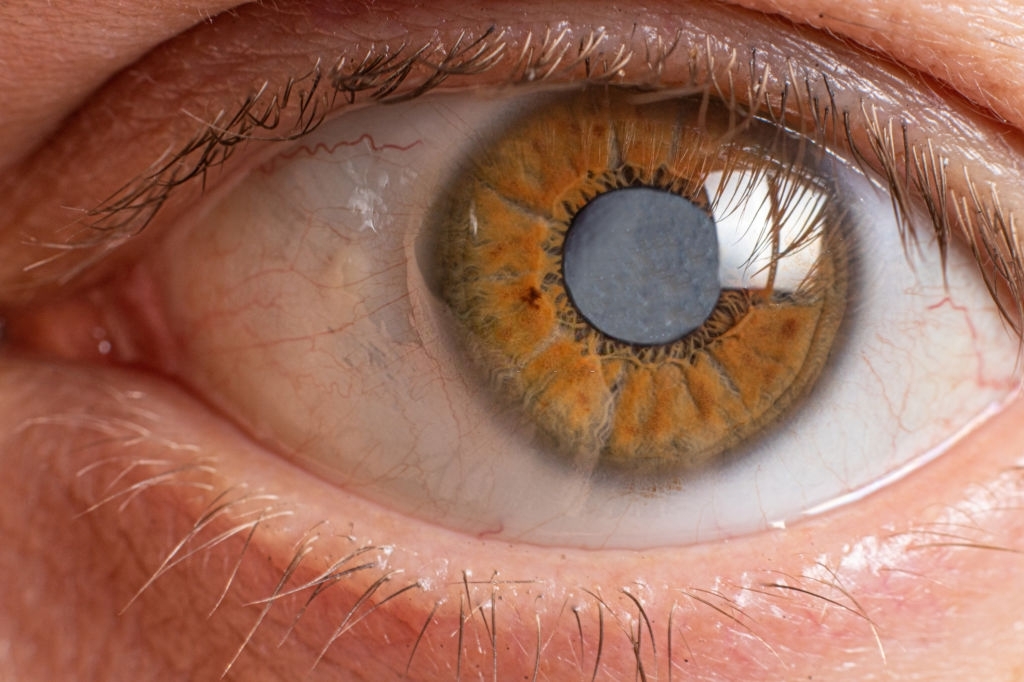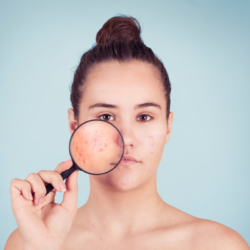Alongside age-related macular degeneration, cataracts are a degenerative eye disease whose prevalence is increasing as the population ages. It is the leading cause of blindness worldwide, with 18 million cases, according to the WHO.
In France, 600,000 cataracts are operated on every year. The incidence of cataracts increases with age, affecting around 20% of people over 65 and rising to almost 66% of people over 85. For more than 20 years, studies have suggested that nutritional factors could, through oxidative stress, and in addition to traditional environmental factors such as exposure to ultraviolet rays and smoking, play a role in the onset of cataracts or, conversely, in their protection against the risk.
What is cataract?
A cataract is a sufficiently dense and extensive opacification of the crystalline lens, leading to a loss of transparency and ultimately to impaired vision. At present, the only curative treatment is surgery. Normally transparent and flexible, the crystalline lens helps to focus light on the retina for clear vision. In the case of cataracts, this ability is impaired, leading to blurred or hazy vision, comparable to looking through frosted glass.
The high cost of these operations has recently prompted a number of studies to look at medicinal alternatives, the development of which is based on the use of appropriate experimental models. With several successively developed protocols, it appears possible to induce a cataract in the subjects under study. These models pave the way for new natural solutions to cataracts, which we will develop further in this article.
What factors can lead to cataracts?
The most common cause of cataracts is ageing. Over time, the proteins in the lens can aggregate, causing it to become cloudy. Other factors can also contribute to its development:
- Genetic factors: a hereditary predisposition may play a role.
- Ocular trauma: injuries to the eye can accelerate cataract formation.
- Prolonged exposure to UV radiation: the sun can damage the lens over the long term.
- Systemic diseases: certain conditions, such as diabetes, can increase the risk of cataracts.
- Medication: long-term use of certain drugs, particularly corticosteroids, is associated with an increased risk.
- Lifestyle habits: smoking and excessive alcohol consumption can promote the development of cataracts.
What are the symptoms of cataracts?
Cataract symptoms develop gradually and may affect one or both eyes. They include:
- Blurred vision: a gradual decline in the sharpness of vision.
- Sensitivity to light: increased discomfort in bright light or glare.
- Changes in colour perception: colours may appear dull or yellowed.
- Night vision problems: difficulty seeing in low light conditions.
- “Halos” around lights: perception of luminous circles around light sources.
- Frequent change of glasses prescription: need to change corrective lenses often.
Healthy dietary advice to prevent and limit cataracts naturally
Avoid smoking:
Smoking is an aggravating factor as it increases the production of reactive oxygen species and reduces antioxidant intake, given the lack of fruit and vegetables in smokers’ diets.
Protect your eyes from sunlight:
The crystalline lens, the body’s only transparent organ, is 63% water and 35% protein, including crystallins, the structural proteins of the lens. Oxidative changes in the crystalline lens, linked to photo-oxidative stress caused by solar radiation and exposure to ultraviolet rays, ultimately lead to a loss of transparency.
Control blood sugar, blood pressure and cholesterol levels if you have diabetes:
In addition to protein oxidation, the role of protein glycation in diabetic cataracts is well established.
Eat fruit and vegetables:
Antioxidant defence systems are represented by endogenous factors (superoxide dismutase, glutathione peroxidase, etc.), themselves dependent on zinc and selenium respectively, as well as exogenous factors (interdependent vitamins C and E) and carotenoids (lutein and zeaxanthin, L and Z).
Experimental data supports the role of these nutritional factors: for example, vitamin C content in the human lens is 10 times higher than in plasma, and up to 30 times higher in other diurnal animal species; and vitamin C-deficient animals develop cataracts.
Are there medicinal plants that can prevent or inhibit senile cataracts?
As part of the research into medicinal plants that can prevent or inhibit senile cataract, several studies have identified promising plant species thanks to their antioxidant and anti-inflammatory properties. These plants include :
- Aegle marmelos (Bael): Known for its role in inhibiting aldose reductase, an enzyme involved in cataract formation in diabetic patients.
- Emblica officinalis (Amla): This plant is used in traditional medicine for its beneficial effects on eye health, and has shown promising results in preventing cataracts.
- Curcuma longa (Curcumin): Curcumin, found in turmeric, is renowned for its antioxidant properties and could play a role in preventing cataracts.
- Ginkgo biloba: Its antioxidant properties, due to the presence of flavonoids and terpenoids, may help protect the lens of the eye against oxidative damage, a key factor in the development of cataracts. In addition, Ginkgo biloba may improve blood circulation, including in the small vessels of the eye, potentially contributing to better eye health. However, it is important to note that research into the effectiveness of Ginkgo biloba in the specific treatment of cataracts is still limited, and further studies are needed to confirm these benefits.
- Ashwagandha: the antioxidant compounds present in Ashwagandha could play a protective role by neutralising free radicals and reducing oxidative stress in the eye, factors which contribute to the development of cataracts. This approach, based on the use of natural sources of antioxidants, offers a potential alternative or complement to conventional cataract treatments.
- Bilberry: Bilberries, which are rich in antioxidants, particularly anthocyanins, play an essential role in neutralising free radicals, which are major contributors to age-related eye disease. A study suggests that the use of bilberry-based food supplements could be beneficial for eye health, in particular for preventing or delaying the development of age-related eye diseases such as cataracts.
These and other plants are being studied for their potential in the management of cataracts, in particular by modulating oxidative stress, a key mechanism in the development of age-related cataracts. It is important to note that this information is based on scientific research and should be used as a complement to conventional medical treatments, and always under the supervision of a health professional.
Genetic and cellular therapies
Healing potential
Genetic and cellular therapies represent a significant advance in the treatment of various diseases, including cataracts. These therapies aim to correct or replace the defective genes that cause the disease, or to use cells to repair or replace damaged tissues. In the case of cataracts, the aim is to restore the transparency and functionality of the lens.
The healing potential of these therapies lies in their ability to directly address the underlying cause of cataract, rather than simply treating its symptoms. In theory, successful genetic or cellular intervention could not only halt the progression of cataracts, but also reverse the damage already caused.
Recent advances
Recent research has shown promising advances in the application of genetic and cellular therapies for the treatment of cataract. These advances include :
- Genetic manipulation: Laboratory experiments have shown that it is possible to modify certain genes involved in the development of cataracts. For example, studies on animal models have succeeded in restoring lens clarity by correcting specific genetic mutations.
- Stem cell therapies: Research has been carried out into the use of stem cells to regenerate or repair damaged crystalline lenses. These studies are still at a preliminary stage, but they offer the prospect of one day being able to replace damaged lens tissue with new, healthy cells.
- Targeted gene delivery: The effectiveness of genetic therapies depends on the ability to precisely deliver corrective genes to lens cells. Advances in viral and non-viral vectors have improved this targeting capacity, increasing the potential efficacy of these treatments.
While these advances are encouraging, it is important to note that genetic and cellular therapies for cataracts are still in their infancy. Many questions remain as to their long-term safety, efficacy and accessibility. Nevertheless, these developments open up exciting avenues for future treatment options, with the potential to overcome some of the limitations of current approaches.
Biotechnology and nanotechnology at the service of cataracts
Significant advances have been made in the fields of biotechnology and nanotechnology as part of innovative cataract treatments. Recent research has focused on the use of pharmacological compounds targeting oxidative stress and lens aggregation, key factors in the development of cataracts.
Among these advances, the use of antioxidants and oxysterols has shown promising results in improving and reversing lens opacity in cataract models. Compounds such as N-acetylcysteine amide and N-acetylcarnosine, which have improved bioavailability, have been studied for their efficacy in topical administration, reducing lens opacity.
In addition, progress has been made in developing more effective delivery methods using nanotechnology, although further research is needed to fully confirm the therapeutic effects of these compounds on cataracts and to improve delivery methods to the lens.
FAQ
Q: What are the risk factors for cataract? A: The main risk factors for cataracts include ageing, excessive exposure to ultraviolet radiation, pre-existing eye diseases, eye trauma and genetic factors.
Q: Can cataracts be prevented? A: Although it is not possible to prevent cataracts completely, certain measures can help reduce the risk of developing the condition. It is advisable to wear sunglasses with UV protection, maintain a balanced diet rich in antioxidants, avoid smoking and consult an ophthalmologist regularly for comprehensive eye examinations.
Q: What are the common symptoms of cataracts? A: Common symptoms of cataracts include blurred vision, increased sensitivity to light, difficulty seeing colours, reduced night vision and double vision.
Q: When should cataract surgery be considered? A: The decision to opt for surgery depends on a number of factors, such as the daily discomfort caused by reduced vision, the impact on daily activities and the recommendation of an ophthalmologist. When cataracts significantly affect quality of life and limit daily activities, lens replacement surgery may be considered.
Q: What are the advantages of new alternative cataract research? A: New alternative research offers a number of potential benefits, including non-surgical treatment options for some patients, the possibility of preventing or delaying cataract progression, faster recovery and better quality of vision post-operatively, and more precise and targeted treatments using nanotechnology.
Q: Are the new cataract treatment alternatives safe? A: The new cataract treatment alternatives are being extensively researched to ensure their safety and effectiveness. Eye health professionals conduct rigorous clinical studies to assess the risks and benefits of these new options before recommending them to patients.
Medical literature and clinical trials:
- Fursova AZ, Gesarevich OG, Gonchar AM, Trofimova NA, Kolosova NG. Dietary supplementation with bilberry extract prevents macular degeneration and cataracts in senesce-accelerated OXYS rats. Adv Gerontol. 2005
- Okuda J, Miwa I, Inagaki K, Horie T, Nakayama M. Inhibition of aldose reductases from rat and bovine lenses by flavonoids. Biochem Pharmacol. 1982
- Thiagarajan, G., Venu, T., & Balasubramanian, D. (2003). Approaches to relieve the burden of cataract blindness through natural antioxidants; use of Ashwagandha (Withania somnifera). Current Science
- Curr Opin Ophthalmol. 2023 Jan 1;34(1):3-8. doi: 10.1097/ICU.0000000000000910. Epub 2022 Nov 14. Advances in drug therapy and delivery for cataract treatment







